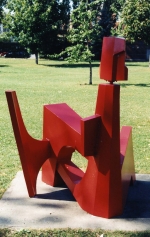Yves Trudeau
Spatio-mobile #1
1966
Presentation of the artwork
Presented on the outdoor site of the Musée de Lachine, the artwork, coloured bright red, stands out in the landscape. At the top, a volume pivots on its axis when blown by the wind. The artwork offers a series of interlinked trapezoids, triangles, and curves. This play on angles and planes gives the structure of the artwork both stability and openness. An effect of lightness has been obtained by detaching the elements from the ground and cutting out an arc at the bottom of the sculpture.Trudeau also produced a second Spatio-mobile, in 1968. Both objects, seeming to synthesize research that he had conducted up to then, marked a pivotal moment in his production. Indeed, the curves in Spatio-mobile #1 refer to gothic architecture, a theme that would frequently be integrated into the artist’s later works, particularly the series Parvis et portail.
Associated events
The artwork was presented first in 1966, at the Stratford Festival in Ontario, then the following year at Place des Arts in Montréal, on the occasion of the event Confrontation 67. In 1968, it was on display at the annual exhibition of the association of sculptors of Québec in Orford, and from 1969 to 1971 it was on site at Man and His World. Finally, it was installed on its present site.
Yves Trudeau
Yves Trudeau received his training at the École des beaux-arts de Montréal. In 1960, he was one of the founders of the Association des sculpteurs du Québec, which later became the Conseil de la sculpture du Québec. He taught at Université du Québec à Montréal, and his works have been presented in numerous solo and group exhibitions. The Côte-Vertu Métro station, inaugurated in 1986, contains his artwork Relief, négatif positif, consisting of two stainless-steel murals.
Yves Trudeau is a member of the Royal Canadian Academy of Arts and became a member of the Order of Canada in 1995.
Yves Trudeau is a member of the Royal Canadian Academy of Arts and became a member of the Order of Canada in 1995.
Presentation of the artwork
Presented on the outdoor site of the Musée de Lachine, the artwork, coloured bright red, stands out in the landscape. At the top, a volume pivots on its axis when blown by the wind. The artwork offers a series of interlinked trapezoids, triangles, and curves. This play on angles and planes gives the structure of the artwork both stability and openness. An effect of lightness has been obtained by detaching the elements from the ground and cutting out an arc at the bottom of the sculpture.Trudeau also produced a second Spatio-mobile, in 1968. Both objects, seeming to synthesize research that he had conducted up to then, marked a pivotal moment in his production. Indeed, the curves in Spatio-mobile #1 refer to gothic architecture, a theme that would frequently be integrated into the artist’s later works, particularly the series Parvis et portail.
Associated events
The artwork was presented first in 1966, at the Stratford Festival in Ontario, then the following year at Place des Arts in Montréal, on the occasion of the event Confrontation 67. In 1968, it was on display at the annual exhibition of the association of sculptors of Québec in Orford, and from 1969 to 1971 it was on site at Man and His World. Finally, it was installed on its present site.
Yves Trudeau
Yves Trudeau received his training at the École des beaux-arts de Montréal. In 1960, he was one of the founders of the Association des sculpteurs du Québec, which later became the Conseil de la sculpture du Québec. He taught at Université du Québec à Montréal, and his works have been presented in numerous solo and group exhibitions. The Côte-Vertu Métro station, inaugurated in 1986, contains his artwork Relief, négatif positif, consisting of two stainless-steel murals.
Yves Trudeau is a member of the Royal Canadian Academy of Arts and became a member of the Order of Canada in 1995.
Yves Trudeau is a member of the Royal Canadian Academy of Arts and became a member of the Order of Canada in 1995.





